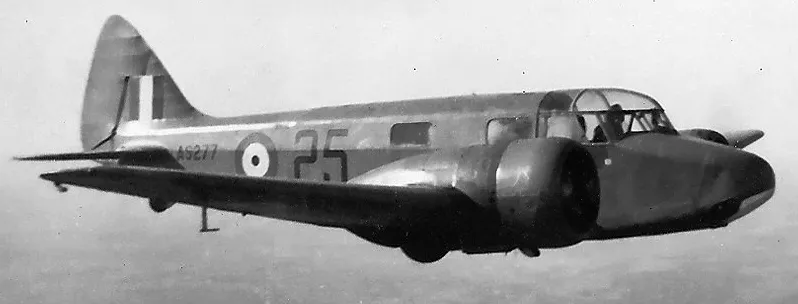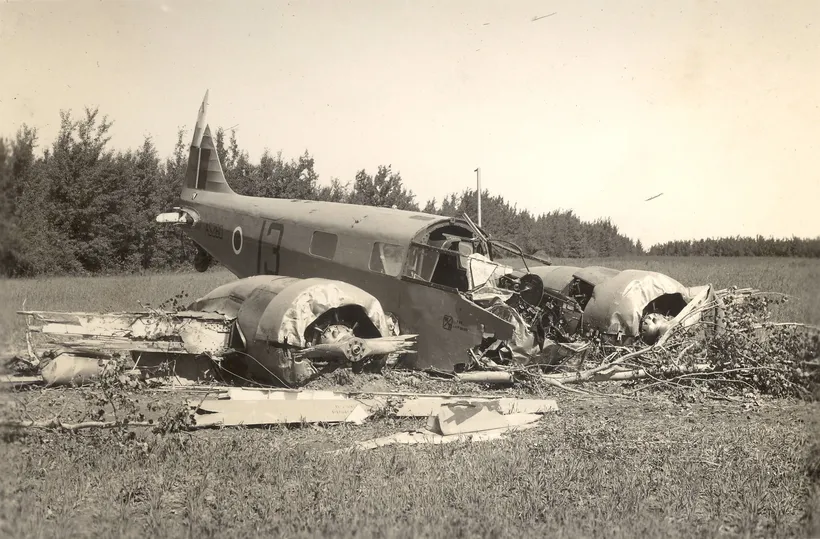Lay, Ronald Edward (Flying Officer)
Killed in Flying Accident 1944-January-02


Birth Date: 1913
Born:
Parents: Son of Mrs. E. Lay, of Tolworth, Surrey, England
Spouse: husband of Isobel W. Lay, of Langham, Essex, England.
Home: Red Deer, Alberta
Enlistment:
Enlistment Date: unkown date
Service
RAFVR
Unit
36 SFTS- Service Flying Training School (RAF)
Base
Penhold, Alberta, Canada
Rank
Flying Officer
Position
Pilot
Service Numbers
128576
Home
Crew or Other Personnel
Oxford AS674
Oxford serial: AS674

Airspeed A.S. 10 Oxford Mk. II, RCAF (Serial No. AS277), 25, in flight over Saskatchewan, 1942.
The Airspeed AS.10 Oxford was a twin-engine monoplane aircraft developed and manufactured by Airspeed. It saw widespread use for training British Commonwealth aircrews in navigation, radio-operating, bombing and gunnery roles throughout the Second World War.
The Oxford was developed by Airspeed during the 1930s in response to a requirement for a capable trainer aircraft that conformed with Specification T.23/36, which had been issued by the British Air Ministry. Its basic design is derived from the company's earlier AS.6 Envoy, a commercial passenger aircraft. Performing its maiden flight on 19 June 1937, it was quickly put into production as part of a rapid expansion of the Royal Air Force (RAF) in anticipation of a large-scale conflict.
As a consequence of the outbreak of war, many thousands of Oxfords were ordered by Britain and its allies, including Australia, Canada, France, New Zealand, Poland, and the United States. Following the end of the conflict, the Oxford continued to achieve export sales for some time, equipping the newly formed air forces of Egypt, India, Israel, and Yugoslavia. It was considered to be a capable trainer aircraft throughout the conflict, as well as being used a general-purpose type. A large number of Oxfords have been preserved on static display. Wikipedia
Aircraft Images
Oxford AS674
Oxford Mk. I AS674
To No. 4 Training Command on 1 October 1941, for use by No. 36 Service Flying Training School at Penhold, Alberta. Category C21 damage at Penhold at 15:25 on 11 January 1942, undercarriage retracted while taxiing in after landing. Category B crash on 10 March 1942. Collided with Oxford AR972 at 30 foot altitude while both aircraft were landing at relief field at Innisfail, Alberta. This aircraft had been cleared to land, but failed to see other aircraft and red signal from flying control. One fatality in other aircraft, no injuries in this aircraft. Was carrying code "47" at time of crash. Winter conversion set installed by No. 10 Repair Depot by 2 July 1942. Category A damage at 12:15 on 2 January 1944. Struck electrical wires during snowstorm, 7.5 miles north of Red Deer, Alberta. Had been on a cross country exercise when weather suddenly changed. Flying Officer R.E. Lay, RAFVR and Leading Aircraftman M.J. Clarke RAAF killed. To No. 10 Repair Depot on 12 January 1944 for inspection. Application to write off from No. 10 RD dated 16 February 1944.1941-09-17 Taken on Strength Eastern Air Command at No. 1 Port Detachment 2019-08-20
1942-January-11 Accident: 36 Service Flying Training School Loc: Aerodrome Penhold Names: Urquhart
1942-March-10 Accident: 36 Service Flying Training School Loc: R1 Names: Gulliver | Stevens
1944-January-02 Accident: 36 Service Flying Training School Loc: Red Deer Alberta Names: Clarke | Lay
1944-02-16 Struck off Strength Struck off, reduced to spares and produce 2019-08-20
Unit Desciption
36 SFTS (36 Service Flying Training School)
Graduates of the EFTS "learn-to-fly" program went on a Service Flying Training School (SFTS) for 16 weeks. For the first 8 weeks the trainee was part of an intermediate training squadron; for the next 6 weeks an advanced training squadron and for the final 2 weeks training was conducted at a Bombing & Gunnery School. The Service schools were military establishments run by the RCAF or the RAF.
There were two different types of Service Flying Training Schools. Trainees in the fighter pilot stream went to an SFTS like No. 14 Aylmer, where they trained in the North American Harvard or North American Yale. Trainees in the bomber, coastal or transport pilot stream went to an SFTS like No. 5 Brantford where they learned multi-engine technique in an Airspeed Oxford, Avro Anson or Cessna Crane.

For Information on RCAF Station Penhold see here
RCAF.Info - RCAF Station Penhold AB
RCAF.Info - Relief Landing Field Innisfail AB
RCAF.Info - Relief Landing Field Blackfalds AB
![]() Harvard Historical Aviation Society
Harvard Historical Aviation Society
![]() Midland Aircraft Recovery Group - Men Of 36 SFTS
Midland Aircraft Recovery Group - Men Of 36 SFTS
![]() Bomber Command Museum Of Canada - 36 SFTS
Bomber Command Museum Of Canada - 36 SFTS
